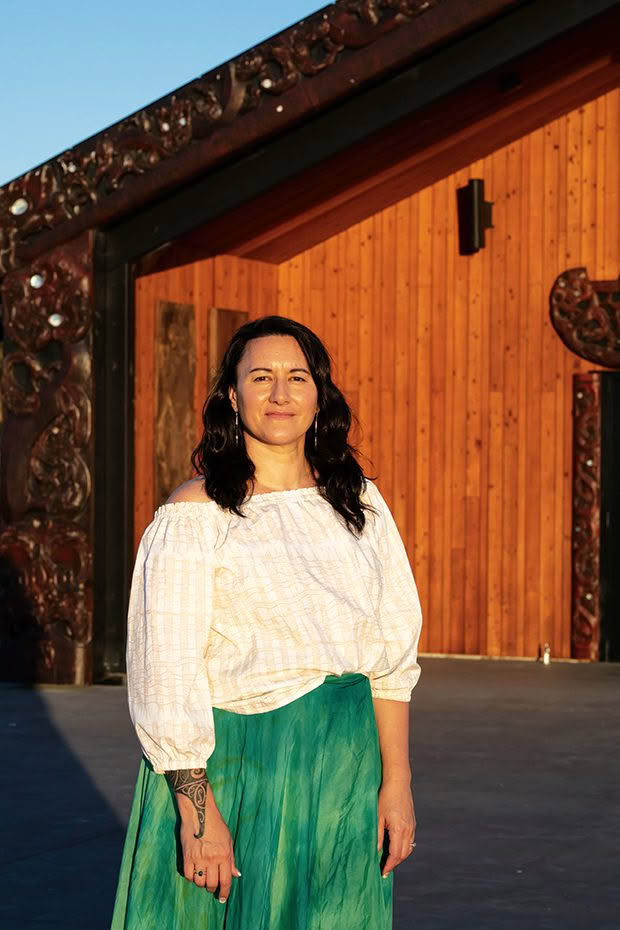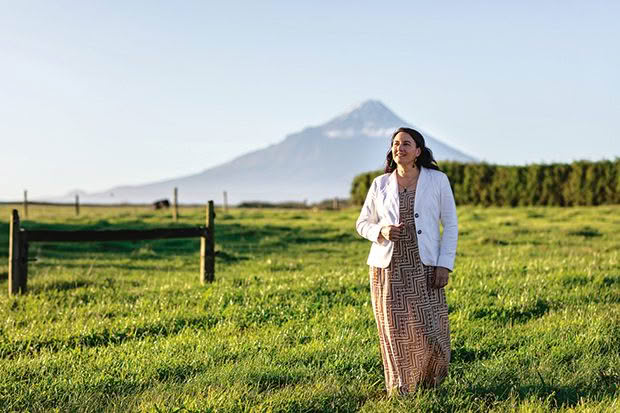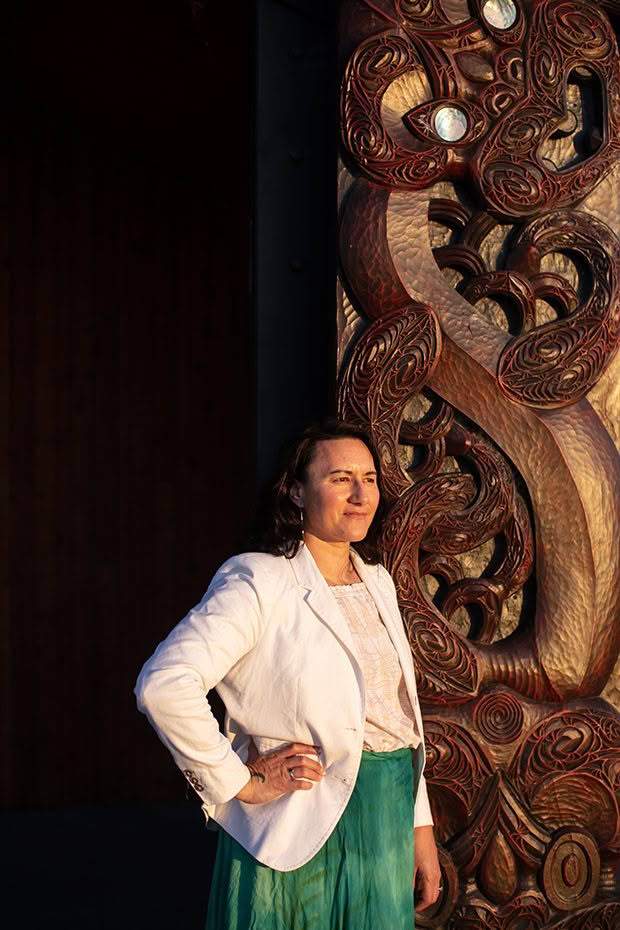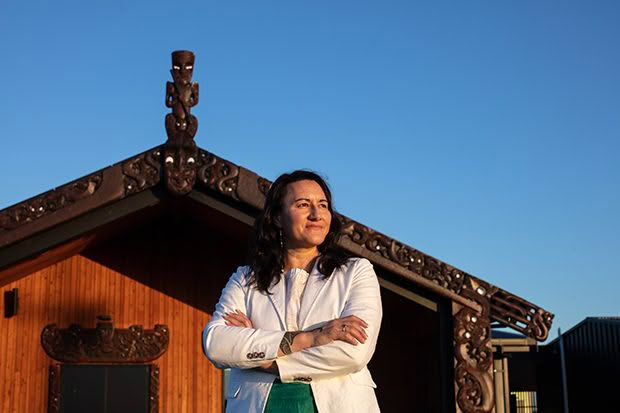For Paula Carr, stepping into the Ngāruahine chair role helped her return to her ahi kaa (home fires)

With Taranaki Maunga physically at her back and spiritually guiding her, Paula Carr is contributing to her Ngāruahine iwi with innovative ideas and by connecting people.
Words: Amokura Panoho Photos: Brooke Lean
PEPEHA
He uri ahau ō Taranaki maunga, Taranaki whenua, Taranaki tangata
Ko Waingōngoro te awa
Ko Aotea te waka
Ko Ngāti Ruanui, Ngāruahine, Ngā Rauru, Te Ātiawa, Taranaki ngā iwi
Ko Ngāti Tūpaea, Ngāti Tānewai, Araukūkū, Kānihi-Umutahi ētehi o ngā hapū
Ko Tītokowaru te toa rangatira
Ko Te Karere Omahuru te tangata
Ko Matekitawhiti me Paul Ponui Mua Carr ōku tūpuna mātua
Ko Spencer Waemura raua ko Suzanne (Foote) Carr ōku mātua
Ko Paula Carr tōku ingoa
Tokowhā ōku tamariki, e rua ngā mokopuna
Ko Dickon Lentell tōku hoa rangatira
Tēnā tātou katoa
Waingōngoro is my river, Aotea my waka
I belong to the tribes of Ngāti Ruanui, Ngāruahine, Ngā Rauru, Te Ātiawa and Taranaki
My sub-tribes are Ngāti Tūpaea, Ngāti Tānewai, Araukūkū and Kānihi-Umutahi
I honour our ancestral chief Tītokowaru and from Ngāruahine iwi descend, among many, from Te Karere Omahuru
Matekitawhiti and Paul Ponui Mua Carr are my grandparents
Spencer Waemura and Suzanne (Foote)
Carr are my parents
I am Paula Carr
I have four children and two grandchildren and am married to Dickon Lentell
Paula is a senior manager at Creative New Zealand (CNZ)/Toi Aotearoa, overseeing the delivery of CNZ’s national strategy for Māori arts. Its vision, “Ngā toi Māori” is highly valued as part of Aotearoa’s distinct identity, and admired globally. She also chairs the Council of Pacific Arts and Culture working group, reviewing the 50-year-old Festival of Pacific Arts & Culture, the world’s largest gathering of indigenous artists in the Pacific. In addition, Paula is chair of Ngāruahine iwi PSGE and a director of Te Kiwai Maui o Ngāruahine iwi commercial board, with various governance roles at marae, hapu and ngā Iwi o Taranaki regional level.
HOW DID YOUR LEADERSHIP ROLES EVOLVE?
I’m the oldest of five children, raised on a dairy and agriculture farm in Normanby, South Taranaki. My dad (Spencer) was involved in marae, hapū and iwi leadership, and my mother was a nurse. As kids, we had to be resourceful and helpful, and Dad ran meetings and delegated roles. I was the secretary, my sister Justine was the treasurer and Dad was the chairman, and that’s how he ran the family and our businesses. We milked cows, worked in our market gardens and the farmers’ markets, packed melons for exporting to Japan and had after-school jobs. Dad was also actively involved with marae, hapū and iwi, and we all had to be very organised to support him.
Dad’s mother, my nana (Matekitawhiti), was the secretary of respected historian Pei Te Hurunui Jones and the inaugural secretary of the Taranaki Māori Trust Board. With me scribing at hui, Dad took us around the maunga (mountain) to many hui (meetings). Nana, a well-known mentor, and Dad, together with others, were active in the early decades of bringing Taranaki land claims and Waitangi Tribunal hearings to the fore, known as Te Muru, me te Raupatu.
Growing up, I was constantly in the company of our kaumātua, listening to their stories and aspirations and helping to record our tribal history. As a teenager, I spent time researching land titles and deeds, preparing data that would feed into the land-claim reports. Eventually, I graduated from being the helpful overhead projector girl at hui to writing reports for iwi hui to putting together the chairman’s report. I also organised travel itineraries to Parliament and all forms of manaakitanga (care) for our manuhiri (visitors) and kaumātua.
It’s no surprise that I became a professional organiser and connector, running events and conferences, business programmes and then, of course, being in the background of several treaty settlements, including Ngāti Ruanui (2001), the Port Nicholson claim (Wellington, 2008), alongside other work Dad did through Parininihi ki Waitotara Trust, the largest land management business in Taranaki.
I graduated from Massey University with a double major in management and event management. My first job was with Sport Taranaki under the Hillary Commission’s He Oranga Poutama programme, leading Māori and women in sports initiatives and the inaugural Taranaki Māori Sports Awards. I did research support for the Office of Commissioner for Children, then several years with Te Puni Kōkiri, managing sponsorship programmes for Kapa Haka and national economic development projects in Māori tourism. With my sister Justine, I settled in Wellington and created an event management and marketing business while raising my four sons with their dad. Later
I worked for the Crown Forestry Rental Trust in funding programmes, supporting more than 30 iwi negotiating with the Crown — an interesting environment, where the Crown’s agenda didn’t necessarily align with iwi aspirations.
From 2017 to 2019, I was at Creative NZ/Toi Aotearoa, developing a national strategy for Māori Arts in Aotearoa. It was a privilege to travel and meet more than 1000 Māori artists, practitioners, advocates, tōhunga and pūkenga (specialists) and reflect their priorities into a strategy for the future.
I’m proud of this contribution, but there is more to do.

WHAT MADE YOU TAKE ON OTHER LEADERSHIP ROLES?
Although I was surrounded by Taranaki Māori whānui, history and tikanga, as the eldest, I wasn’t raised with the language. When my younger siblings came along, they enjoyed the benefits of kōhanga reo and kura Māori. I came instead from an era where our kaumātua aspired that we went away, got educated and brought those skills home.
I inevitably stepped into a tribal leadership role, and this is the right time. It’s important to return to the ahi kaa (home fires), not only for my own journey and reclamation of identity but to support the many whānau who remain and never left, who will always throw an extra tea towel your way — or shovel, depending on where your skills lay. For me, it’s the whiteboard pen. With this move, I hope other whānau members return home in their time, and we need to show them how to do it.
I am all about, ‘How can I be of use?’ I am a big-picture thinker and strategist. Now, in my later life, I require people’s support to advocate, influence, be a connector, a weaver of ideas and facilitate all the necessary relationships.
Though I wasn’t directly involved in the Ngāruahine claim, I knew the background through my nana and my other kaumātua. It has been satisfying to take on roles based at home as a representative for Kānihi-Umutahi hapū and marae trustee for Māwhitiwhiti-Kānihi Pā, who were recipients of $5.5 million of Provincial Growth Funding for our new marae, which opened in December 2021.
WHAT HAVE YOUR LEARNT ALONG THE WAY, AND KEY INFLUENCERS IN YOUR LIFE?
I am grateful for leaders of my parents’ and grandparents’ generation — incredible leaders such as the late Aunty Daisy Noble in the iwi and the late Dr Ngatata Love in business who, among many others, looked after me. In part, they knew that I would be coming through for a reason. My father and my late grandmother are, and were, extremely tikanga-driven and very principled in leadership. It’s a calling and a responsibility.
Today, we have to figure it all out together and carry forward the visions of our elders the best we can. In the case of Ngāruahine, we are very hapū-centric, so it’s about enabling the hapū to deliver on their aspirations.
I’ve also been part of a network of wāhine in leadership roles in a range of professions named Black Pearls (after the waiata by Moana Maniapoto). I have raised my children alongside two of these women and their own families, Brandi Hudson (Ngāti Maniapoto, Ngāti Rārua, Ngāti Pikiao) and Nicole Anderson (Ngāpuhi). They are formidable in their own right and champions for Māori development.

WHAT ARE THE CHALLENGES FOR YOUR IWI?
It’s important to convey that the Post Settlement Governance Group (PSGE) is responsible for managing and growing the assets and distributing the wealth to the iwi. We are part of the makeup of the iwi; we are not the iwi. The majority of our iwi live outside the Taranaki region. Although our numbers are certainly increasing, our beneficiary register is approximately 7000, and we know there are more of us out there.
Many of our people struggle with the Crown-defined mandated authority. However, we (the trust) know our place alongside the other Ngāruahine entities and interest groups, six hapū and 10 marae.
Aunty Daisy advised me about leadership: “Be focused on little steps that keep moving you forward, and don’t be afraid of standing on your own two feet.”
WHAT CAN THE READERS ALIGN WITH AND GET ALONGSIDE TO SUPPORT?
Firstly, we are focused on strengthening ourselves, ensuring we are replenishing roles, and maintaining access to our own reo and mātauranga (knowledge) for our children.
Readers with whakapapa are welcome to reconnect. We are focused on rebuilding our economic, cultural and social wellbeing. That means, when we are ready, becoming visible in our own backyard and telling our stories as mana whenua, tangata whenua and kaitiaki of our lands, our people and our environment.
Partnerships and impact investments for social outcomes will support growth and change to encourage our people to return home. Also, they will support the wider communities around us and benefit everyone, not just our own people. For example, the commercial arm of the iwi is developing Te Rere o Kapuni (formerly known as Dawson’s Falls Lodge), purchased in 2016 as a sustainable eco-tourism commercial venture providing employment, training and career opportunities for Ngāruahine members.
The Te Ara Toiroa Procurement Strategy was launched to create employment opportunities for iwi members to leverage off various iwi investments. This includes housing and a combined multipurpose, multi-use iwi and community facility in the Ngāruahine rohe. It provides a head office, a creative cultural space to support large iwi activities and potentially a long-term lease-back with the South Taranaki District Council. It may also include a management contract for the civic facilities (library, hall, pools).
These achievements demonstrate a strong vision and board culture. Talented kaupapa kaimahi investing in the right areas, engaging the right advisors, and holding a commitment to reach higher for our people.
Ngāruahine Deed of Settlement

Te Korowai o Ngāruahine Trust was established in 2016 to manage the settlement of $67.5 million and four culturally significant sites — the Waipakari Reserve, Te Kohinga Reserve, Te Ngutu o te Manu and Te Poho o Taranaki.
In 2022, the trust reported total assets of $111 million and a priority focus on Toitū Te Whenua — the Ngāruahine whenua reacquisition initiating the return of deferred selection and right of first refusal properties
to hapū.
BACKGROUND
The Ngāruahine tribal area extends from the southwest side of Mount Taranaki and Egmont National Park, where the Taungātara Stream is the northern-most boundary entering the sea between Ōpunake and Pīhama, to the Waihī Stream at the southernmost boundary between Ohāwe and Hāwera.
Ngāruahine is one of eight iwi of Taranaki. The six hapū (sub-tribes) with mana to claim ahi-ka-roa (long occupation) are descendants of Aotea Waka and ancestors Turi and Rongorongo.
THE CROWN IS COMPENSATING FOR
Before 1860, Ngāruahine were prosperous and economically successful and retained ownership of their lands and resources. In the late 1850s, some Ngāruahine helped northern Taranaki iwi resist Crown efforts to acquire land. The Crown declared Māori preventing surveys as being in rebellion and commenced hostilities against them in 1860. Some Ngāruahine entered the war on the side of the non-sellers. This phase of war ended in 1861 before conflict resumed in 1863, and Ngāruahine again travelled north to engage with Crown forces. In 1865, the Crown confiscated 1.2 million acres (about 485,673 hectares) of Taranaki land, including all of the Ngāruahine rohe. The confiscations were indiscriminate, depriving “loyal” and “rebel” Māori of their lands.
War continued, and in early 1866, Crown forces entered the Ngāruahine rohe and used scorched earth tactics, devastating several Ngāruahine villages and associated food stores, livestock, and crops. As a result of the Crown’s military campaigns, Ngāruahine suffered severe hardship.
The process to compensate “loyal” Māori for confiscating their land began in the mid-1860s, before the fighting had ceased in southern Taranaki. This made it difficult for Ngāruahine people to participate in hearings. By 1880, when the West Coast Commissions investigated Māori grievances, none of the Compensation Court awards to Ngāruahine had been implemented.
In the late 1860s, Ngāruahine and other southern Taranaki iwi resisted the extension of European settlement onto their lands, and in 1868, the Ngāruahine leader Tītokowaru took up arms. After a series of victories against Crown forces, Tītokowaru lost his support for unclear reasons and was pursued by Crown forces into the Taranaki interior.
In the early 1870s, many Ngāruahine returned to their lands on the Waimate Plains. Through the 1870s, the Crown tried to secure nominally confiscated Ngāruahine land for European settlement with formal and informal payments to Māori and by promising to provide reserves and protect significant Ngāruahine sites. These promises were not fulfilled. By the late 1870s, many Ngāruahine were unsure about the status of their lands.
By 1879, some Ngāruahine had relocated to Parihaka in central Taranaki and supported its leaders, Te Whiti and Tohu, and their movement for Māori peace and independence. Ngāruahine people participated in campaigns of peaceful resistance initiated at Parihaka. Some were arrested and exiled to South Island prisons, where they were detained in harsh conditions for at least 17 months without trial.
In November 1881, more than 1500 Crown troops invaded and dismantled Parihaka, and Ngāruahine people were then displaced from the settlement.
In the early 1880s, the West Coast Commissions returned about 26,000 acres to Ngāruahine as reserves. However, the Crown retained and on-sold more than 145,000 acres of Ngāruahine land to settlers. Almost all of the Ngāruahine land returned was under non-customary individualised title, and much of it was located in the bush.
Reserves were not returned to Māori outright but were put under the control of the Public Trustee, which then sold or leased in perpetuity large areas to European farmers.
In 1963, the titles of all remaining Taranaki reserves were amalgamated, leaving owners without specific interests in customary land. Today, less than five per cent of the area that was reserved is in Māori freehold ownership, and approximately 50,000 acres remain under the perpetual leasing system.
Apart from marae, Ngāruahine, as an iwi, retain less than 300 acres of coastal Tauranga waka reserves.
During the 20th century, Crown efforts to address Taranaki Māori grievances failed. Some inquiries were limited in their scope. Others provided compensation payments that were not discussed with Ngāruahine and other Taranaki Māori. The Taranaki Māori Claims Settlement Act of 1944 stated the sums were a full settlement of claims relating to the confiscations and Parihaka. There is no evidence that Ngāruahine or other iwi agreed to this.
Love this story? Subscribe now!
 This article first appeared in NZ Life & Leisure Magazine.
This article first appeared in NZ Life & Leisure Magazine.
